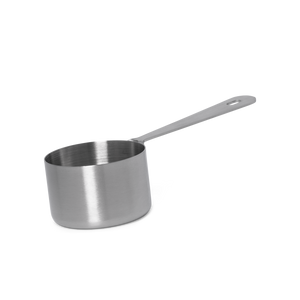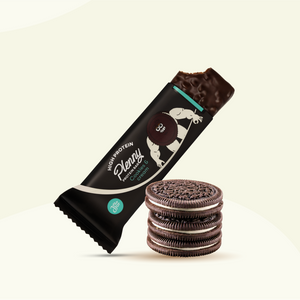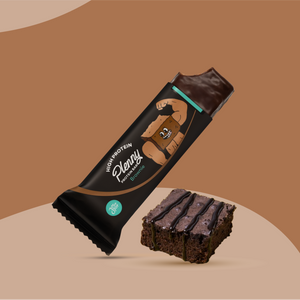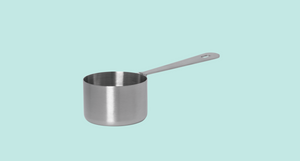
Introduction
Jimmy Joy aims to be the healthiest meal scientifically possible. This is achieved by sourcing the best ingredients which result in the highest health benefits. A part of a healthy diet is eating low glycemic. The glycemic index (GI) is a measurement system that ranks food according to their effect on the blood glucose levels. Foods with a low GI, are slowly digested and absorbed causing a small and slow rise in blood glucose. Therefore, they are preferred over high glycemic food which causes a fast rise and drop of blood glucose. An example of a food with a high GI is white bread.
White bread is comparable to glucose by giving the highest possible glycemic index. This can be explained by the composition of bread, which is mainly large chains of glucose. On the contrary, foods with a low glycemic index contain complex carbs, a complex nutrient profile and a high fibre content. This is also the case with the Plenny Shake v3.0. Figure 1 shows how blood glucose levels differ for low GI and high GI foods. In order to verify if the composition of the Plenny Shake actually results in an effect on blood glucose levels compatible with low GI food, it is useful to compare Plenny Shake over a high GI food in order to detect the differences and draw a conclusion on the GI of Plenny Shake (1–4).
Research question: What is the effect on blood glucose levels of Plenny Shake v3.0 compared to high GI food?
Hypothesis: The trend of the blood glucose rise of Plenny Shake v3.0 is compatible with the low GI line (figure 1).

Figure 1: Effect of high and low glycemic index foods on blood glucose levels.
Method
Nine participants of varied ages and genders were selected. An important criterion to participate in this research was to have no medical conditions or using medication that may affect blood glucose levels. The trial took place on two non-consecutive trial days, part 1 and part 2. On part 1, the participants consumed 55,6 grams Plenny Shake v3.0 (test food), containing 25 grams available carbohydrates. Likewise, in part 2, the participants consumed 50 grams of white bread (reference food) which is equal to 25 grams available carbohydrates.
For both testing days, each subject fasted for 12 hours overnight where they were permitted to consume nothing apart from water. Following this, each subject tested their fasting blood glucose consumption using a glucometer (Accu-Chek® (Roche)). Thereafter, they consumed the amounts of Plenny Shake (day 1) and white bread (day 2) mentioned before. Blood glucose readings were taken again at 15-minute intervals up to 120 minutes after consumption, giving a total of 9 readings. Blood glucose levels were recorded in mmol per litre. Furthermore, the Area under the Curve (AUC) was calculated in order to collect the blood glucose rise/drop within different time intervals.
Results
Table 1 shows the Area Under the Curve (AUC) recorded and their mean for Part 1 (Plenny Shake v3.0) at 15 minutes intervals over 120 minutes (n=9).
Table 1: Area under the curve (AUC) of blood glucose levels as a result of Plenny Shake v3.0 consumption per 15 minutes (min.)
|
Plenny Shake v3.0 |
||||||||||
|
Min. |
1 |
2 |
3 |
4 |
5 |
6 |
7 |
8 |
9 |
Average |
|
15 |
0,050 |
0,113 |
0,088 |
0,138 |
0,063 |
0,038 |
0,100 |
0,050 |
0,050 |
0,076 |
|
30 |
0,175 |
0,200 |
0,213 |
0,250 |
0,200 |
0,138 |
0,138 |
0,200 |
0,275 |
0,199 |
|
45 |
0,175 |
0,013 |
0,200 |
0,150 |
0,313 |
0,225 |
0,063 |
0,238 |
0,338 |
0,190 |
|
60 |
0,088 |
-0,138 |
0,075 |
0,000 |
0,350 |
0,087 |
0,088 |
0,050 |
0,138 |
0,082 |
|
75 |
0,025 |
-0,063 |
0,013 |
-0,050 |
0,300 |
-0,050 |
0,175 |
-0,050 |
0,125 |
0,047 |
|
90 |
-0,100 |
0,063 |
-0,013 |
-0,025 |
0,213 |
-0,025 |
0,188 |
0,075 |
0,087 |
0,051 |
|
105 |
-0,163 |
0,038 |
-0,013 |
-0,062 |
0,100 |
0,037 |
0,138 |
0,063 |
0,087 |
0,025 |
|
120 |
-0,113 |
-0,075 |
0,013 |
-0,062 |
0,038 |
0,175 |
0,125 |
0,013 |
0,150 |
0,029 |
The AUC and the mean values as recorded from Part 2 (white bread) are shown in table 2.
Table 2: Area under the curve (AUC) of blood glucose levels as a result of white bread consumption.
|
White bread |
||||||||||
|
Min. |
1 |
2 |
3 |
4 |
5 |
6 |
7 |
8 |
9 |
Average |
|
15 |
0,000 |
-0,013 |
0,075 |
-0,013 |
0,175 |
0,088 |
0,163 |
0,050 |
0,125 |
0,072 |
|
30 |
0,013 |
0,113 |
0,225 |
0,263 |
0,575 |
0,288 |
0,413 |
0,225 |
0,363 |
0,275 |
|
45 |
0,025 |
0,113 |
0,225 |
0,675 |
0,775 |
0,425 |
0,550 |
0,288 |
0,375 |
0,383 |
|
60 |
0,163 |
-0,100 |
0,125 |
0,750 |
0,425 |
0,275 |
0,550 |
0,025 |
0,313 |
0,281 |
|
75 |
0,225 |
-0,038 |
-0,100 |
0,475 |
0,038 |
0,250 |
0,413 |
-0,213 |
0,225 |
0,142 |
|
90 |
0,087 |
0,013 |
-0,225 |
0,350 |
-0,087 |
0,413 |
0,225 |
-0,163 |
0,000 |
0,068 |
|
105 |
-0,025 |
-0,013 |
-0,125 |
0,450 |
-0,113 |
0,425 |
0,163 |
-0,087 |
-0,138 |
0,060 |
|
120 |
-0,088 |
0,013 |
-0,050 |
0,325 |
-0,087 |
0,425 |
0,138 |
-0,062 |
-0,150 |
0,051 |
The results are graphically illustrated in figure 2, which shows the comparison of blood glucose response between white bread and Jimmy Joy Plenny Shake v3.0 (n=9).

Figure 2: Effect of Plenny Shake v3.0 and white bread on blood glucose levels.
Outliers
Two participants showed blood glucose values that were significantly different from the other observations. When these participants were excluded from the study a faster spike and drop became visible after the consumption of white bread. Nevertheless, the effect on blood glucose after consumption of the Plenny Shake remained roughly similar to when the outliers were included. Figure 3 shows the graphically illustrated results when the outliers are excluded from the results.

Figure 3: Effect of Plenny Shake v3.0 and white bread on blood glucose levels with exclusion outliers.
Conclusion
The blood glucose levels recorded during part 1 (Plenny Shake v3.0) of the test, showed a slow rise and a slow drop. When these graphs (Figure 4 and 5) are compared, this line is compatible with the low GI line. On the contrary, the blood glucose levels recorded in part 2 of the test (white bread), showed a fast rise, resulting in a peak rise in 45 minutes after consumption. After these 45 minutes, the blood glucose levels dropped fast. This result is comparable with the high GI line. In conclusion, it is shown that Plenny Shake v3.0 behaves as a low glycemic index food.
This result is confirmed by the Oxford Brookes Centre for Nutrition and Health, which has shown our products having a low glycemic index of 21. This was determined by having our products tested using ISO standards, which are highly validated.

Sources
- Harvard Nutrition Source. A good guide to good carbs: The glycemic index [Internet]. Harvard Health. [cited 2020 Apr 9]. Available from: https://www.health.harvard.edu/healthbeat/a-good-guide-to-good-carbs-the-glycemic-index
- Harvard Nutrition Source. Choosing good carbs with the glycemic index [Internet]. Harvard Health. [cited 2020 Sep 26]. Available from: https://www.health.harvard.edu/staying-healthy/choosing-good-carbs-with-the-glycemic-index
- Miller JB, Pang E, Bramall L. Rice: a high or low glycemic index food? Am J Clin Nutr. 1992 Dec 1;56(6):1034–6.
- Jenkins DJ, Wolever TM, Taylor RH, Barker H, Fielden H, Baldwin JM, et al. Glycemic index of foods: a physiological basis for carbohydrate exchange. Am J Clin Nutr. 1981 Mar 1;34(3):362–6.

 Everything You Need In One Meal
Everything You Need In One Meal
 Stay Full For 3-5 Hours
Stay Full For 3-5 Hours




















 Product added to cart
Product added to cart





















